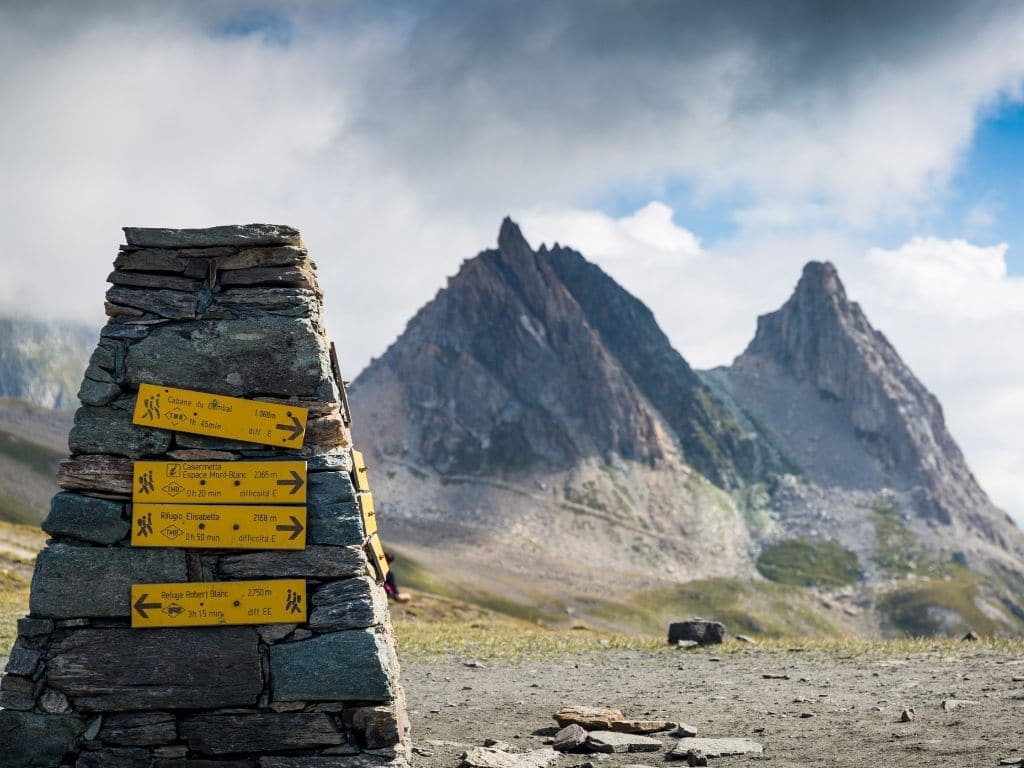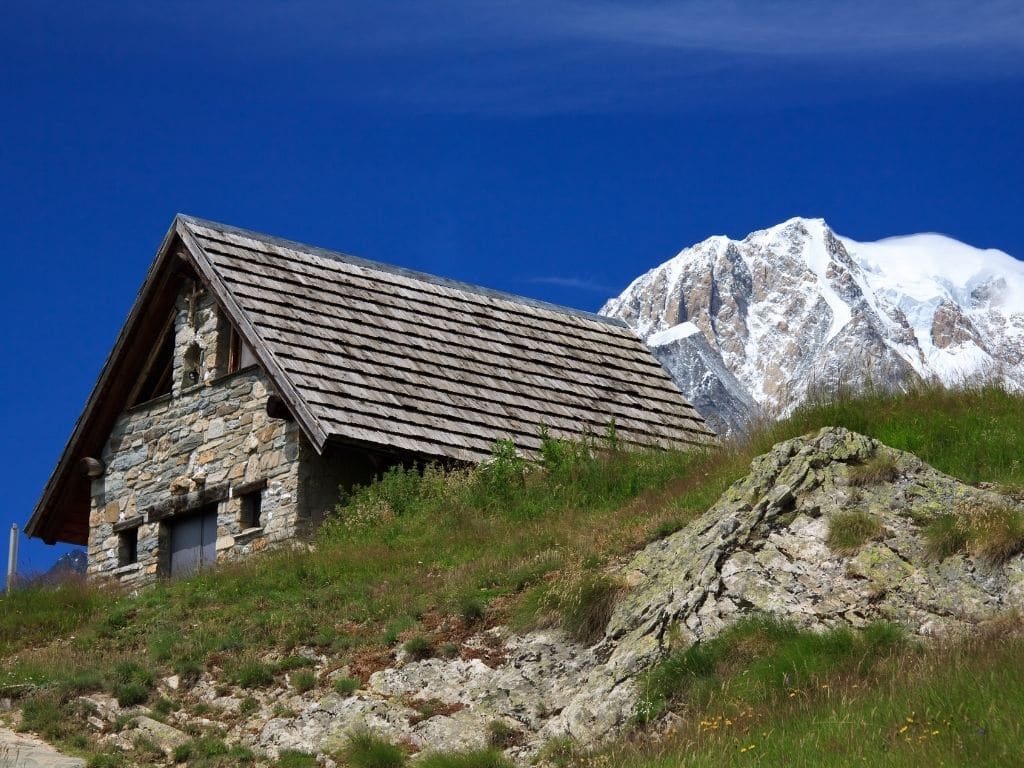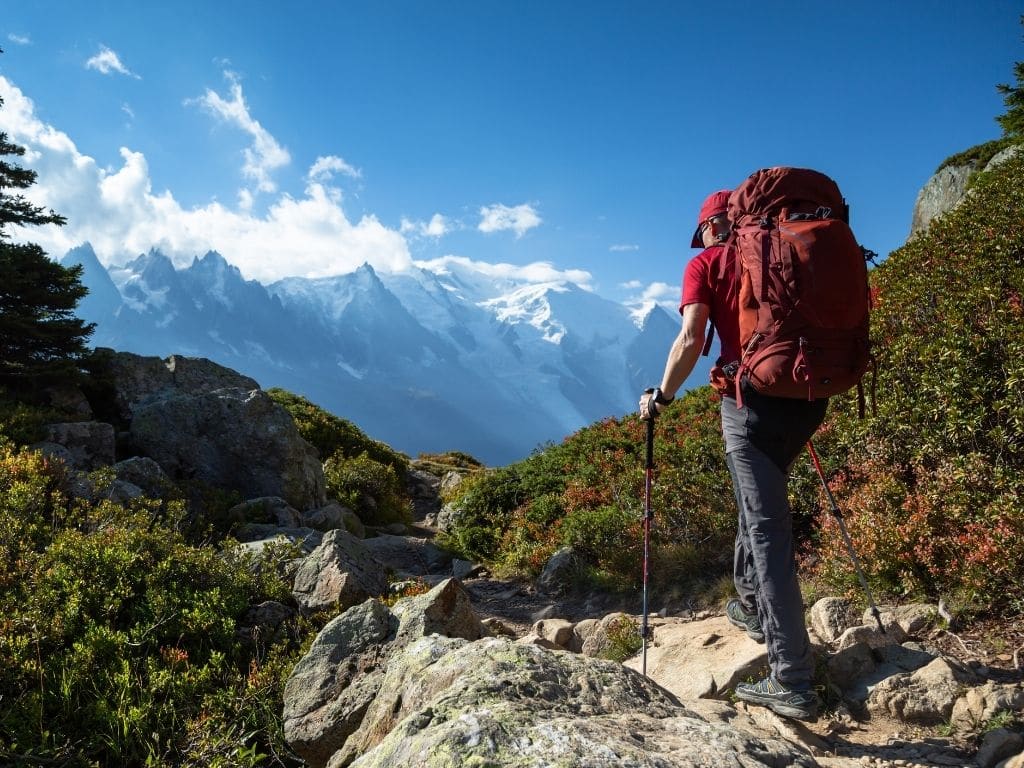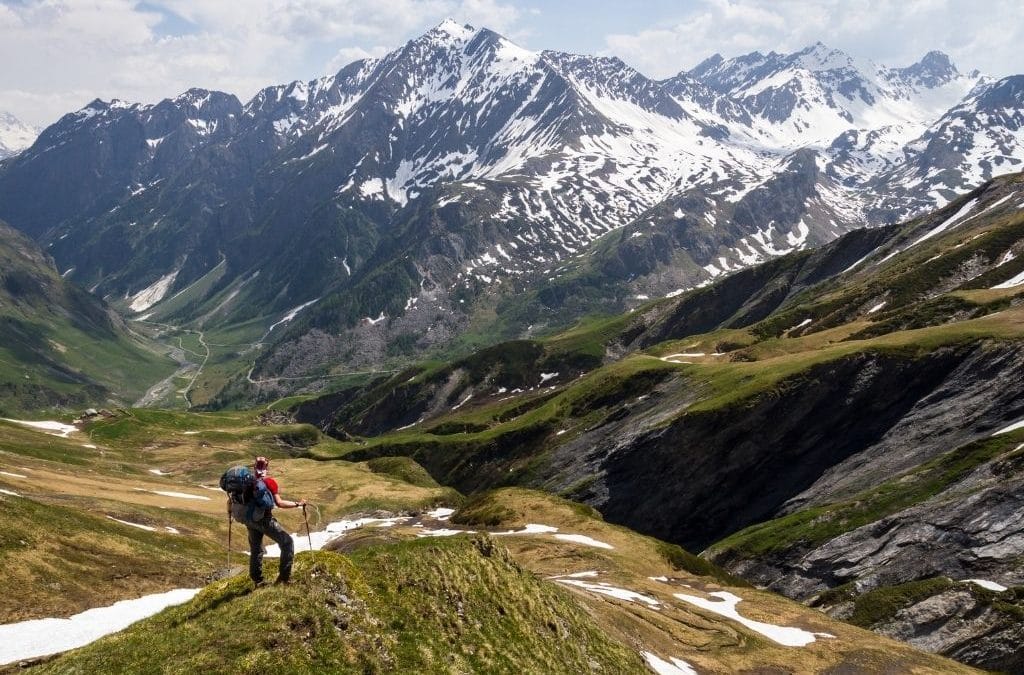To do the Tour du Mont Blanc without a guide or with a guide, several trekking possibilities are available. Depending on the route you choose, your adventure will last between 7 and 11 days and will be more or less sportive.
In any case, you will have the chance to walk through the three countries bordering the highest peak in Western Europe: France, Italy and Switzerland!
To do the Tour du Mont Blanc in complete serenity, you can choose to be accompanied by a specialized agency or a mountain leader. Your trip will be all the more comfortable as you won’t have to take care of anything! 🙂
For those who prefer to live this experience alone, with family or friends, it is possible to do the Tour du Mont Blanc without a guide.
Thanks to the good signposting of the Tour du Mont Blanc trails, you will not encounter any insurmountable technical difficulties. Moreover, numerous accommodations (mountain refuges, gites, inns…) allow you several options to imagine your stages!
In this article, discover the advice of our guides and the questions to ask yourself to succeed in your Tour du Mont Blanc on foot without a guide 🙂
Quick navigation :
- Choose the route
- Define the period
- Find information
- Book nights in refuges and gites
- Get physically ready
- Take the right equipment
1 – Doing the Tour du Mont Blanc without a guide: find your path

To do the Tour du Mont Blanc without a guide, several itineraries are available.
The fulll Tour du Mont Blanc without a guide
This is the classic itinerary to do the Tour du Mont Blanc without a guide.
With more than 10,000 meters of altitude difference, you will walk on nearly 160 kilometers and will cross three different countries: France, Switzerland and Italy.
This complete loop does not leave out any passage. It guarantees you the possibility of discovering all that the Tour du Mont Blanc has to offer: fauna, flora, grandiose landscapes…
To do the Tour du Mont Blanc without a guide via this itinerary, you will need between 9 and 11 days of travel, depending on the pace you set for yourself.
Do the Tour du Mont Blanc in 7 days
If you don’t want to or can’t do the whole Tour du Mont Blanc, it is possible to shorten the duration of the Tour du Mont Blanc to only 6 days (with a sporty pace) or to 7 days (preferable not to suffer the stages).
To do this, it is possible to avoid doing the first or last stage of the classic loop, by shifting your arrival or departure, for example.
Another solution, widely chosen by trekkers, is to transfer by public transport (bus, shuttle, cable car), for example between the communes of La Fouly and Champex. Depending on your preference, it is also possible to use private vehicles (taxis).
To enjoy your Tour du Mont Blanc without a guide and in complete freedom, you can choose Trekking Mont Blanc to provide all these transfers. Our agency also carries out the transfer of luggage between your different places of accommodation. So, you walk light carrying only your bag for the day! 🙂
Do the Tour du Mont Blanc in part
It is also possible to do only a part of the Tour du Mont Blanc. If you don’t have the time or don’t feel like doing the whole Tour du Mont Blanc without a guide, it is possible to do only a selected portion.
For example, by doing a 4 days trek between Les Houches and Courmayeur you will have the opportunity to discover: the Turc’s mountain pastures, splendid views on the glaciers and the Mont Blanc, the passage of the Fours pass (located at 2665 m of altitude!). You will discover the famous Aosta Valley, while discovering the famous typical culture of this Italian region, once arrived in Courmayeur.
A short trek in terms of duration but intense in terms of the emotions it brings!
2 – What period should I choose to do the Tour du Mont Blanc without a guide?
The recommended season to do the Tour du Mont Blanc without a guide is summer. The rest of the year, most of the accommodations are closed and the snow makes several portions dangerous, even sometimes, impracticable without adequate equipment (crampons, ice axe, etc).
Mid-June to mid-July
As soon as spring arrives, the refuges on the TMB and the gîtes start to open their doors. In mid-June, temperatures are generally mild and ideal for hiking: it is neither too hot nor too cold!
At this time of the year, floral activity is intense in the mountains, the ground is covered with flowers and the air stirs with their scent. At this time of year, doing the Tour du Mont Blanc without a guide is particularly pleasant, especially because the number of hikers is still modest.
Be careful though: at this time of year, snow can still persist in several places at altitude and/or with little exposure to the sun (e.g. at the Fenêtre d’Arpette).
If you want to do the Tour du Mont Blanc without a guide, it will be essential to get information from the tourist offices, the hut wardens and/or the PGHM (Peloton de Gendarmerie de Haute Montagne).
From mid-July to mid-August
At this time of the year, the days are long and sunny. Except for a few exceptions, the paths are generally clear: ideal conditions for trekking and the Tour du Mont Blanc without a guide.
But it is also the time when the TMB is the most frequented by groups of hikers from all over the world. It’s the ideal time to meet new people, discover the activities of the mountain villages and enjoy lively evenings in the mountain huts!
From mid-August to mid-September
There are fewer and fewer people on the Tour du Mont Blanc trails and the temperatures are still perfect for a wonderful trek.
Even if the days tend to get shorter, they are still long enough to allow you to enjoy them fully. It is therefore an ideal time to do the Tour du Mont Blanc!
The atmosphere is calm and comfortable. Later, the days start to be too short and the temperatures start to be too low. It gets cold quickly in the mountains, and the huts start to close.
3 – Where to find information?
To do the Tour du Mont Blanc without a guide, it is very important to be well informed beforehand. There are many sources of information, but you still need to know who to contact. Here are some ideas!
- Websites and blogs specialized on the Tour du Mont Blanc: as for example on the blog of the Trekking Mont Blanc website. You will find dozens of blog articles on this subject (equipment needed, best routes…).
- The official website of the Tour du Mont Blanc is also a good source of information, especially thanks to the possibility to book the huts directly online.
- Finally, nothing beats the experience of those who have already done the Tour du Mont Blanc without a guide. For this, many bloggers share their experience online.
- The official topo guide of the Tour du Mont Blanc: if you want to dig deeper into the subject, you have the possibility to buy the official topo guide of the Tour du Mont Blanc. Inside, you will find a lot of information about the history of the regions crossed, complete topographic maps of the area, the itineraries of some stages and detailed descriptions of your route.
- IGN maps: indispensable for orientation and for a more serene Tour du Mont Blanc without a guide. Models of maps to choose from:
- The Tour du Mont Blanc map on a scale of 1:50 000
- or
- The IGN 3630 OT map – Chamonix, Massif du Mont-Blanc at 1:25000 scale
- Map IGN3531 ET – Saint-Gervais-les-Bains, Massif du Mont Blanc at 1:25000 scale
If you decide to choose Trekking Mont Blanc to organize your Tour du Mont Blanc without a guide, we provide you with a detailed road book of your route as well as an annotated IGN map of your itinerary.
4 – Reservation of the refuges to do the Tour du Mont Blanc without a guide

If you don’t want to do the Tour du Mont Blanc by bivouac, you must find accommodation that will welcome you each night on your Tour du Mont Blanc without a guide.
Mountain huts on the TMB
Located in the middle of the mountains, they are an essential variable to take into account when designing your itinerary for the Tour du Mont Blanc without a guide as they will be your starting and finishing points.
Generally, these refuges offer a half-board system. You spend the night in a dormitory or a small room, and you are served the evening meal (usually a soup, a starch dish and a dessert. A menu specially designed to replenish the calories lost during a day in the mountains).
In the morning, breakfast is included in the package. For the day, most of the refuges offer lunch baskets (to be booked in the evening, when you arrive).
The gites and inns
Contrary to the refuges located in the middle of the mountains, the gites and inns are located in the villages we cross. Generally, they are much more comfortable because they are easier to access by road! You will be sure to sleep on good bedding.
The ideal resting place for a break during your unguided Tour of Mont Blanc.
But if we had only one piece of advice to give you, it would be to book well in advance. A long time.
On the Tour du Mont Blanc, some nights in the high season refuges are sold out as early as February. This is why we strongly advise you to book as soon as possible! For most of them, you can do it directly on the Internet. For some lodgings, it is done the old fashioned way, by phone.
Please remember to specify allergies and special diets (vegetarian, pork-free, etc.) when booking, so as not to have any unpleasant surprises when you arrive.
If you don’t want to take any risk with the choice of accommodation during your Tour du Mont Blanc without a guide, Trekking Mont Blanc can take care of it for you. You won’t have to do anything, because we take care of everything.
As trekking professionals have early access to mountain hut bookings, we can free you from the stress of finding accommodation for each night.
5 – How to prepare physically to do the Tour du Mont Blanc without a guide?
To do the Tour du Mont Blanc without a guide, it is generally advisable to train beforehand.
For an efficient training in order to achieve the Tour du Mont Blanc, we advise you to practice hiking regularly, on various terrains and with an increasing level of difficulty (longer distances, with more difference in altitude, steeper outings…).
It is also best to hike for two or three days to get used to spending the night in the mountains.
But if you don’t have the possibility to do so, then you can also train through other sports activities.
Running: very good for the cardio, it increases your respiratory capacity as well as your muscular endurance. However, beware of injuries, as it would be a shame to have to cancel your Tour du Mont Blanc a few days before the start. This is why when you run, it is important to listen to your body and to lengthen the duration of your sessions very gradually to avoid hurting yourself.
Cycling: very good sport to work your cardio and your respiratory capacities while discovering new landscapes at the rhythm of the pedals. To get off to a good start, start with sessions on the flat for 1 to 2 hours, then gradually increase the duration to work on your endurance. If you wish, you can tackle mountain passes to improve your fitness while taking on physical challenges and admiring the beauty of the landscape.
Swimming: This is the ideal sport if you want to work on your endurance while protecting your joints. There is no better sport to avoid injuries. Swimming is also the perfect sport to work your whole body in one session.
6 – A list of the equipment to hike the TMB

Before you start your unguided Tour du Mont Blanc, you need to be equipped accordingly. That’s why at Trekking Mont Blanc, we have prepared a list of equipment that you absolutely must take with you when you start your Tour du Mont Blanc without a guide:
The ideal equipment for the TMB:
- A hiking bag adapted to the mountain, and strong enough to resist the mountain for several days. The ideal volume is 30 to 40 liters if you plan to spend your nights in refuges or hostels.
- High upper mountain boots with good grip soles, made of Vibram or equivalent to absorb shocks, and equipped with a Gore Tex membrane or equivalent for waterproofing. And above all, your shoes must hold your ankles well.
- Hiking poles: to help you distribute the weight of your body and backpack over all four limbs. In addition to helping you in the effort of climbing, they relieve the joints and ensure a better balance.
- A pair of sunglasses: with a protection factor of 3 or 4 to avoid pain when exposed to prolonged reflection on snow and glaciers.
- A protection for the head: buff, hat or cap will avoid sunstroke.
- Purification tablets or a water filter: Even if it is easy to find drinking water on the Tour du Mont Blanc, it is always very important to have a purification solution at hand.
- The map and compass duo for orientation: if you decide to leave for several days, forget the GPS that you will not always be able to recharge.
- Sunscreen: if you don’t want to come back with heatstroke everywhere!
- Thin gloves for the morning and evening: because yes, in the mountains at these times of the day, it is cold!
- The very obvious medical kit to be able to provide first aid in case of a more or less serious problem
And finally the clothes not to forget:
- Several pairs ofhiking socks adapted to avoid blisters and pain.
- Protective and durable hiking pants that will resist wear and tear and possible snags from branches and rocks.
- T-shirts made from synthetic fibres or merino wool that help wick away perspiration.
N.B.: the anti-bacterial property of merino wool naturally eliminates bad odours. Magic, isn’t it? - A fleece for better thermal insulation. It will allow you to better conserve body heat.
- A waterproof and windproof jacket that will protect you from the elements and mother nature.
You are ready to do the Tour du Mont Blanc in total freedom! For any question about the trek or the organization of your adventure, contact our agency of guides specialists of the TMB! 🙂

